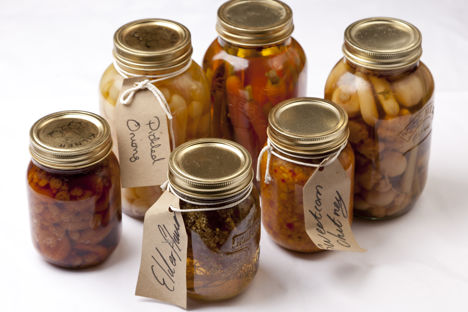
A guide to pickled vegetables
Chloë King shares all the tips, tricks and advice novice picklers will ever need to take fresh vegetables and turn them into jarred delicacies.
Mrs Beeton advised that although pickles may be purchased ‘at as low a rate as they can usually be made at home… we would advise all housewives who have sufficient time and convenience, to prepare their own’. This advice still stands, housewife or not – supermarkets are full of mass-produced, sterile jars of pickled veg that are, in the most part, made with cheap or synthetic vinegar bumped up with preservatives. Making your own is much better.
Excellent pickles rely on high-quality, fresh ingredients. Producing your own means you can choose the very best produce and opens the door to exploring many different flavours and effects that can be achieved through spicing and fermentation.
You can pickle almost any veg providing it is fresh and unblemished – you may be surprised to learn of a recent craze for fermented watermelon rinds. Good pickling is about suspending veg at its peak in clear animation: to preserve and even boost its nutritional content. This can be done through simple chutney making, water pickling (an example of lactic acid fermentation), oil pickling and vinegar pickling. Each method has its own special qualities and techniques but the broad advice for all is to use good stuff in the correct quantities and to not be afraid.
The biggest error novice picklers make is by using veg that is under-ripe or on the turn – that bargain crate of cherries at the boot fair may be good for a pie, but not the jar. Pickling works best with vegetables that are low in starch, as you can imagine if you’ve ever overcooked spuds that have made their water gelatinous.
Clear as day
For vinegar pickles, as we are concentrating on here, we’re looking to create crystal clear and fragrant pickling liquor that will not become diluted or otherwise influenced by the leeching of water from the veg. It is for this reason that most vegetable pickles require salting first, to draw out water. It is of upmost importance that the adequate ratios of preservative are used – that is the holy trio of salt, sugar and acetic acid, and this begins here.
Dry salting or brining usually takes one or two days, and veg should be well rinsed before processing further. As a guide, a good pickling brine is made up of 50g salt to 600ml water, or a tablespoon of salt to 450g vegetables. For cooked pickles, certain veg such as beetroot may be salted during cooking. Leiths suggests cooking beetroots in boiling water until tender before cooling then packing, covering with cold vinegar and adding more salt.
The salt must be pure sea salt or rock salt as commercial table salt contains additives that may cloud your pickle. Pink Himalayan salt is currently popular; Maldon and Halen Mon are good British brands.
Typically cauliflower, beetroot, cabbage and green beans are good starting blocks for pickling beginners. Fruits and high-sugar veg are generally well suited to chutney making, though that’s not to say they can’t be pickled with a bit of care. Mrs Beeton has a recipe for pickled cherries preserved in equal proportions of vinegar and sugar. The cherries are left to stand for a week; the liquor is strained off, boiled, poured hot over the fruits and then sealed in jars when cool.
Seasoned to perfection
So, how to season your vinegar? Again, there are big variations here with some, such as Nordic pickles, tending to be sweeter and more dilute than others. Leiths general purpose pickling vinegar is made up with equal parts whole spices including mace, cinnamon, allspice berries, black peppercorns, mustard seeds, as well as four cloves, a chilli and 15g fresh root ginger. The spices are put in 1.1 litres of malt vinegar, brought to a simmer, then left to steep for three hours.
Whole spices are generally used as they look good, are easy to remove and do not cloud the liquor. You must use vinegar with at least five percent acetic acid, preferably six percent, and choose a type that suits your recipe. Asian pickles are likely to require rice vinegar; Nordic regions prefer white wine or distilled malt and British or Indian pickles work with dark malt or cider vinegar.
How long to keep your pickle before eating is a big question, and recipes vary enormously with some refrigerator or quick pickles being ready to eat within a day or two. Others, such as raw pickled onions, need six months or more to mature and delicacies like lime pickle can improve with years.
As a rough guide, veg sliced thinly or with a high water and sugar content requires less pickling time than those with more starch and larger proportions. Pickles matured for less time will generally be crunchier and punchier than those that have been left to mature, so a good rule is to go with what you like.
Provided the pickles have been prepared and sealed carefully they will keep for a long time, which brings us to the business of what equipment to use. Stainless steel pans should be used for cooking anything with high acidity as iron and copper pans can spoil. Good strong glass containers such as Kilner jars are best, as they are easy to sterilise in soapy water and then the oven (150°C for twenty-five minutes) and seal well with a vacuum rubber seal provided you use new seals for each batch. Pay attention to your recipe as many pickles need to be kept refrigerated either immediately or straight after fermentation begins, and all should be kept in a cool, dark place.


